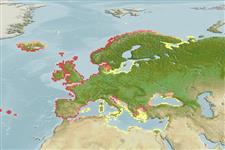Common names from other countries
Environment: milieu / climate zone / depth range / distribution range
Sinh thái học
; Mức độ sâu 6 - 8 m (Ref. 118694). Temperate; 76°N - 25°N, 31°W - 61°E
Northeast Atlantic, Arctic and the Mediterranean: North and Celtic seas. Temperate to polar.
Length at first maturity / Bộ gần gũi / Khối lượng (Trọng lượng) / Age
Maturity: Lm ? range ? - ? cmCommon length : 5.1 cm SHL con đực/không giới tính; (Ref. 360)
Shell: quite high conical spire, with an outer lip characteristically broadened and fingered, looking like a bird's foot; whorls are angular with a nodular median keel (two in the body whorl); the suture is hardly incised; outer lip of the aperture is thickened, and the inner lip produces a marked columellar callus; development of the external fingers marks the attainment of maturity; sculpture consists of the nodular keel and thin spiral grooves that extend over the whole surface; coloration is variable, white, beige, darkish chestnut, reddish brown or patched, axially flamed with draker shades than the base color; operculum is horny, ellipsoidal and with a terminal nucleus. Body: pink or reddish with whitish spots, foot is very long and narrow; eyes sessile, set at the bases of the long tentacles; mantle cavity has one gill, the osphradium/penis; radula is taenioglossan.
This is a carnivorous species (Ref. 96498).
Life cycle and mating behavior
Chín muồi sinh dục | Sự tái sinh sản | Đẻ trứng | Các trứng | Sự sinh sản | Ấu trùng
Members of the order Neotaenioglossa are mostly gonochoric and broadcast spawners. Life cycle: Embryos develop into planktonic trocophore larvae and later into juvenile veligers before becoming fully grown adults.
Sabelli, B. and H.S. Feinberg (eds.). 1879. (Ref. 360)
IUCN Red List Status (Ref. 130435)
CITES status (Ref. 108899)
Not Evaluated
Not Evaluated
Human uses
| FishSource |
Các công cụ
Các nguồn internet
Estimates based on models
Price category
Unknown.
